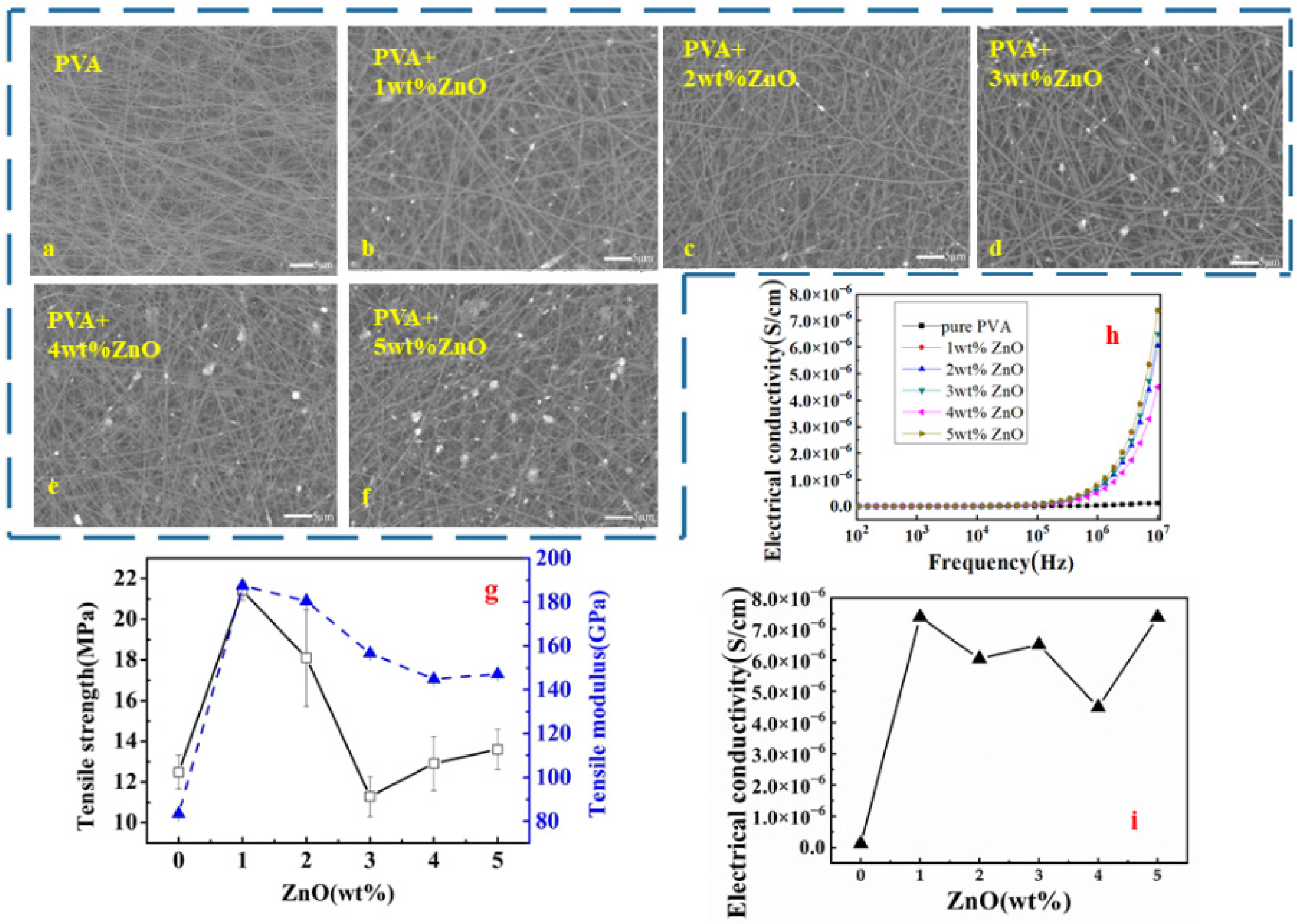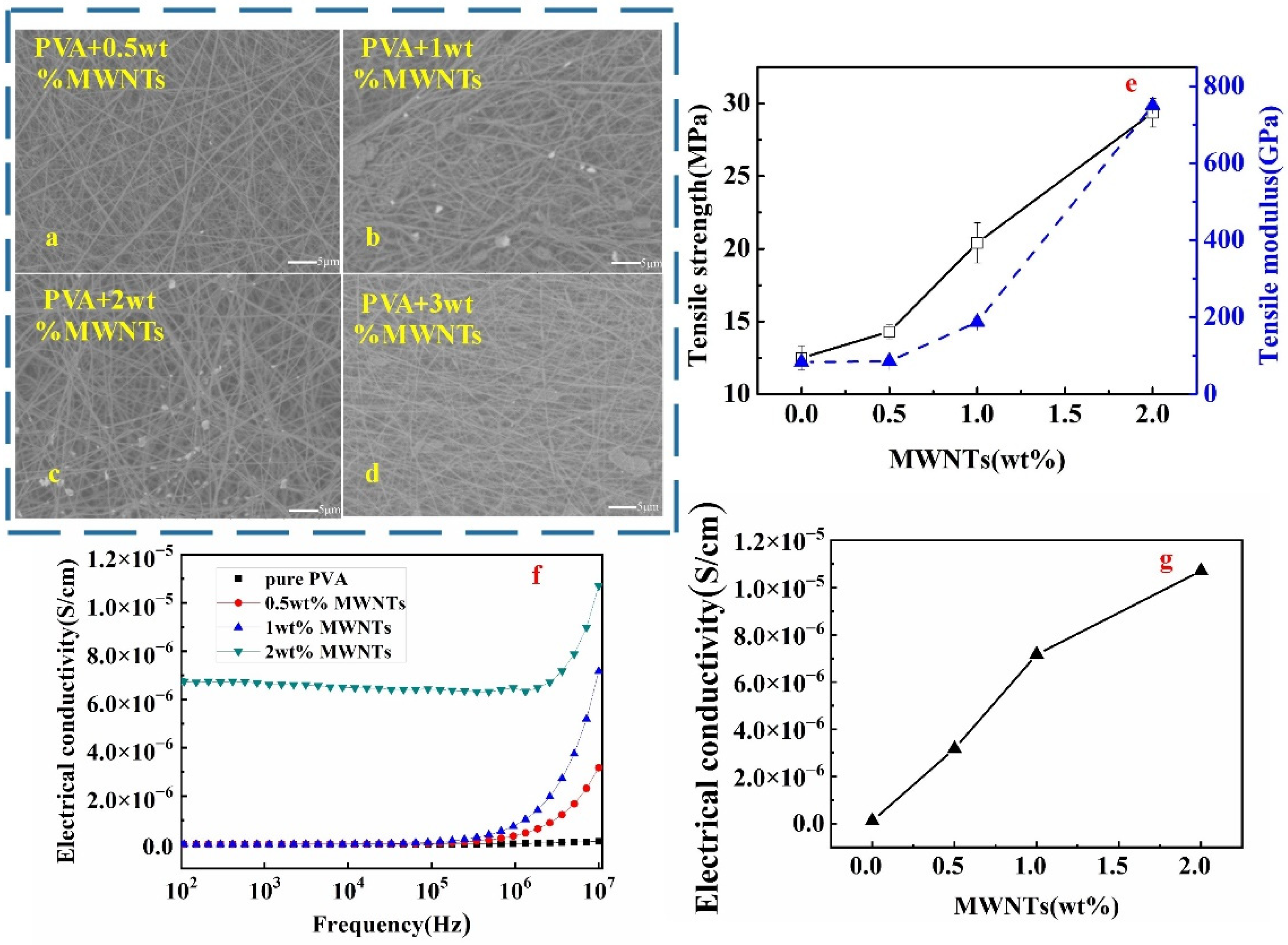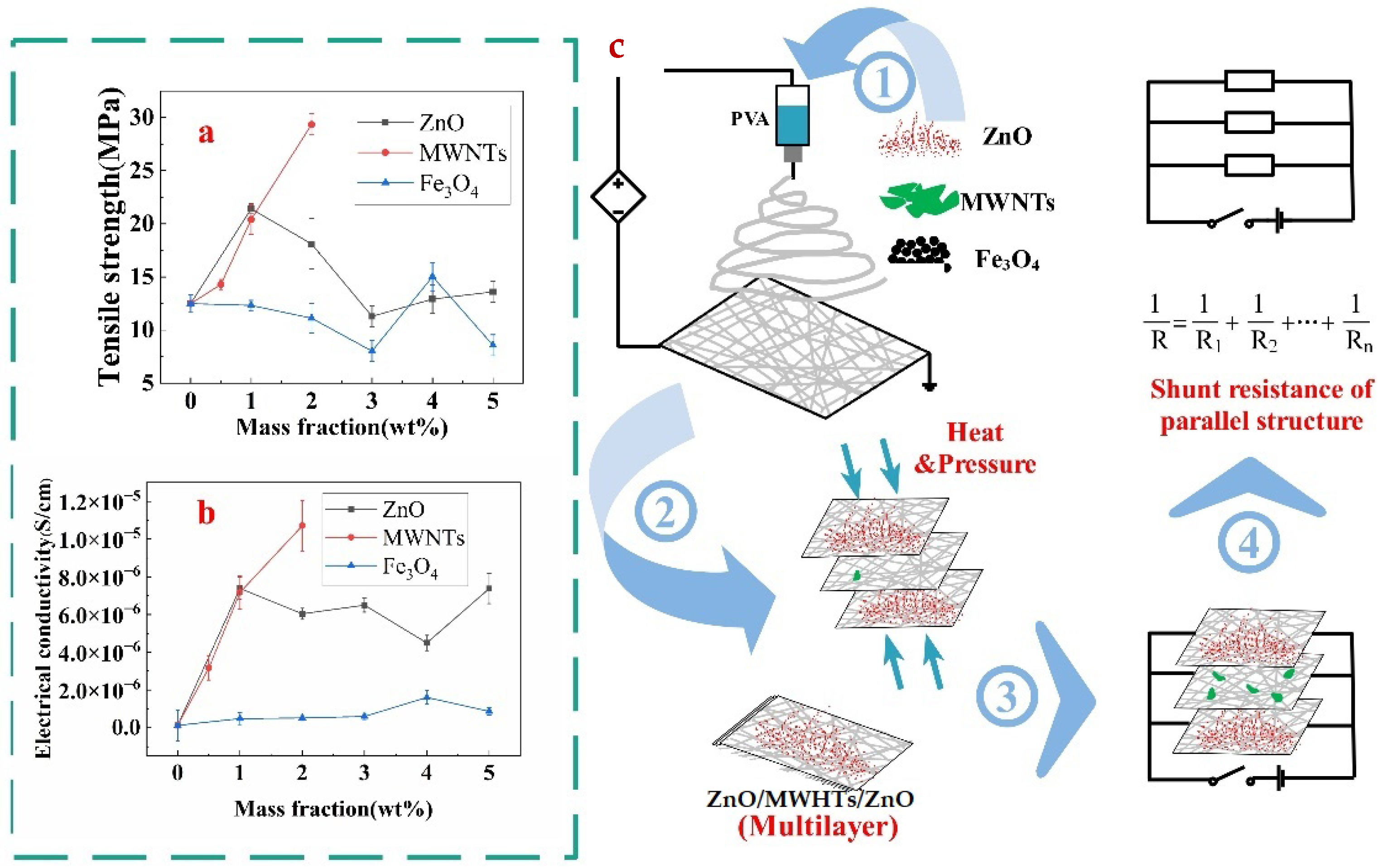The Electrical Conductivity and Mechanical Properties of Monolayer and Multilayer Nanofibre Membranes from Different Fillers: Calculated Based on Parallel Circuit
Abstract
1. Introduction
2. Materials and Methods
2.1. Material
2.2. Production of Monolayer Nanofibre Membrane via Electrospinning
2.3. Preparation of Multilayer Nanofibre Membrane
2.4. Characterization of Monolayer and Multilayer Nanofibre Membranes
3. Results and Discussion
3.1. Production of PVA Monolayer Nanofibre Membranes with Different Electroconductive Fillers (ZnO, Fe3O4, and MWNTs)
3.2. Tensile Properties of Monolayer Nanofibre Membrane with Different Electroconductive Fillers (ZnO, Fe3O4, and MWNTs)
3.3. Electroconductivity Performance of Monolayer Nanofibre Membrane with Different Electroconductive Fillers (ZnO, Fe3O4, and MWNTs)
3.4. Preparation of Multilayer Nanofibre Membranes and Analysis of Electroconductivity Performance
4. Conclusions
Author Contributions
Funding
Institutional Review Board Statement
Data Availability Statement
Conflicts of Interest
References
- Shang, Z.; Wycisk, R.; Pintauro, P. Electrospun composite proton-exchange and anion-exchange membranes for fuel cells. Energies 2021, 14, 6709. [Google Scholar] [CrossRef]
- Li, Y.; Xiao, S.; Luo, Y.; Tian, S.; Tang, J.; Zhang, X.; Xiong, J. Advances in electrospun nanofibers for triboelectric nanogenerators. Nano Energy 2022, 104, 107884. [Google Scholar] [CrossRef]
- Wang, X.X.; Yu, G.F.; Zhang, J.; Yu, M.; Ramakrishna, S.; Long, Y.Z. Conductive polymer ultrafine fibers via electrospinning: Preparation, physical properties and applications. Prog. Mater. Sci. 2021, 115, 100704. [Google Scholar] [CrossRef]
- Fuh, Y.K.; Wang, B.S.; Tsai, C.Y. Self-powered pressure sensor with fully encapsulated 3D printed wavy substrate and highly-aligned piezoelectric fibers array. Sci. Rep. 2017, 7, 6759. [Google Scholar] [CrossRef] [PubMed]
- Lee, J.K.Y.; Chen, N.; Peng, S.; Li, L.; Tian, L.; Thakor, N.; Ramakrishna, S. Polymer-based composites by electrospinning: Preparation & functionalization with nanocarbons. Prog. Polym. Sci. 2018, 86, 40–84. [Google Scholar]
- Monteserín, C.; Blanco, M.; Murillo, N.; Pérez-Márquez, A.; Maudes, J.; Gayoso, J.; Laza, J.M.; Hernáez, E.; Aranzabe, E.; Vilas, J.L. Novel antibacterial and toughened carbon-fibre/epoxy composites by the incorporation of TiO2 nanoparticles modified electrospun nanofibre veils. Polymers 2019, 11, 1524. [Google Scholar] [CrossRef]
- Ghosh, T.; Das, T.; Purwar, R. Review of electrospun hydrogel nanofiber system: Synthesis, properties and applications. Polym. Eng. Sci. 2021, 61, 1887–1911. [Google Scholar] [CrossRef]
- Gugliuzza, A.; Drioli, E. A review on membrane engineering for innovation in wearable fabrics and protective textiles. J. Membr. Sci. 2013, 446, 350–375. [Google Scholar] [CrossRef]
- Rogina-Car, B.; Kovačević, S.; Đorđević, S.; Đorđević, D. Influence of Washing and Sterilization on Properties of Polyurethane Coated Fabrics Used in Surgery and for Wrapping Sterile Items. Polymers 2020, 12, 642. [Google Scholar] [CrossRef]
- Tomczykowa, M.; Plonska-Brzezinska, M.E. Conducting polymers, hydrogels and their composites: Preparation, properties and bioapplications. Polymers 2019, 11, 350. [Google Scholar] [CrossRef]
- Holdstock, P.; Smallwood, J. Measurement of electrostatic discharge ignition risks from conductive components of Personal Protective Equipment. J. Electrost. 2013, 71, 509–512. [Google Scholar] [CrossRef]
- Cho, D.; Hoepker, N.; Frey, M.W. Fabrication and characterization of conducting polyvinyl alcohol nanofibers. Mater. Lett. 2012, 68, 293–295. [Google Scholar] [CrossRef]
- Chen, Z.C.; Chang, T.L.; Pan, T.C.; Chiang, D.; Tseng, S.F. A facile approach to fabrication and characterization of conductive conjugated polyvinyl alcohol/graphene composite nanofibers. Mater. Lett. 2018, 233, 130–133. [Google Scholar] [CrossRef]
- Srikanth, C.; Sridhar, B.C.; Prasad, M.V.N.; Mathad, R.D. Characterization and DC conductivity of novel ZnO doped polyvinyl alcohol (PVA) nano-composite films. J. Adv. Phys. 2016, 5, 105–109. [Google Scholar] [CrossRef]
- Wang, S.; Wang, C.; Zhang, B.; Sun, Z.; Li, Z.; Jiang, X.; Bai, X. Preparation of Fe3O4/PVA nanofibers via combining in-situ composite with electrospinning. Mater. Lett. 2010, 64, 9–11. [Google Scholar] [CrossRef]
- Ramos, P.G.; Morales, N.J.; Goyanes, S.; Candal, R.J.; Rodríguez, J. Moisture-sensitive properties of multi-walled carbon nanotubes/polyvinyl alcohol nanofibers prepared by electrospinning electrostatically modified method. Mater. Lett. 2016, 185, 278–281. [Google Scholar] [CrossRef]
- Wang, C.; Zuo, Q.; Wang, L.; Long, B.; Salleh, K.M.; Anuar, N.I.S.; Zakaria, S. Diameter optimization of polyvinyl alcohol/sodium alginate fiber membranes using response surface methodology. Mater. Chem. Phys. 2021, 271, 124969. [Google Scholar] [CrossRef]
- Zhao, K.; Li, S.; Huang, M.; Shi, X.; Zheng, G.; Liu, C.; Dai, K.; Shen, C.; Yin, R.; Guo, J.Z. Remarkably anisotropic conductive MWCNTs/polypropylene nanocomposites with alternating microlayers. Chem. Eng. J. 2019, 358, 924–935. [Google Scholar] [CrossRef]
- Chen, Y.Y.; Juang, J.Y. Finite element analysis and equivalent parallel-resistance model for conductive multilayer thin films. Meas. Sci. Technol. 2016, 27, 074006. [Google Scholar] [CrossRef]
- Gao, W.; Zheng, Y.; Shen, J.; Guo, S. Electrical properties of polypropylene-based composites controlled by multilayered distribution of conductive particles. ACS Appl. Mater. Interfaces 2015, 7, 1541–1549. [Google Scholar] [CrossRef]
- Sui, X.M.; Shao, C.L.; Liu, Y.C. White-light emission of polyvinyl alcohol/ZnO hybrid nanofibers prepared by electrospinning. Appl. Phys. Lett. 2005, 87, 113115. [Google Scholar] [CrossRef]
- Bantz, C.; Koshkina, O.; Lang, T.; Galla, H.J.; Kirkpatrick, C.J.; Stauber, R.H.; Maskos, M. The surface properties of nanoparticles determine the agglomeration state and the size of the particles under physiological conditions. Beilstein J. Nanotechnol. 2014, 5, 1774–1786. [Google Scholar] [CrossRef] [PubMed]
- Jang, K.S.; Yeom, H.Y.; Park, J.W.; Lee, S.H.; Lee, S.J. Morphology, electrical conductivity, and rheology of latex-based polymer/nanocarbon nanocomposites. Korea Aust. Rheol. J. 2021, 33, 357–366. [Google Scholar] [CrossRef]
- Jeong, J.S.; Moon, J.S.; Jeon, S.Y.; Park, J.H.; Alegaonkar, P.S.; Yoo, J.B. Mechanical properties of electrospun PVA/MWNTs composite nanofibers. Thin Solid Film. 2007, 515, 5136–5141. [Google Scholar] [CrossRef]
- Latif, I.; AL-Abodi, E.E.; Badri, D.H.; Al Khafagi, J. Preparation, characterization and electrical study of (carboxymethylated polyvinyl alcohol/ZnO) nanocomposites. Am. J. Polym. Sci. 2012, 2, 135–140. [Google Scholar] [CrossRef]
- Rueda, L.; Saralegui, A.; d’Arlas, B.F.; Zhou, Q.; Berglund, L.A.; Corcuera, M.A.; Mondragon, I.; Eceiza, A. Cellulose nanocrystals/polyurethane nanocomposites. Study from the viewpoint of microphase separated structure. Carbohydr. Polym. 2013, 92, 751–757. [Google Scholar] [CrossRef]
- Dong, C.; Yuan, C.; Bai, X.; Li, J.; Qin, H.; Yan, X. Coupling mechanism between wear and oxidation processes of 304 stainless steel in hydrogen peroxide environments. Sci. Rep. 2017, 7, 2327. [Google Scholar] [CrossRef]
- Wei, Y.; Zhang, X.; Song, Y.; Han, B.; Hu, X.; Wang, X.; Lin, Y.; Deng, X. Magnetic biodegradable Fe3O4/CS/PVA nanofibres membranes for bone regeneration. Biomed. Mater. 2011, 6, 055008. [Google Scholar] [CrossRef]
- Papageorgiou, D.G.; Li, Z.; Liu, M.; Kinloch, I.A.; Young, R.J. Mechanisms of mechanical reinforcement by graphene and carbon nanotubes in polymer nanocomposites. Nanoscale 2020, 12, 2228–2267. [Google Scholar] [CrossRef]
- Jiang, M.; Seney, R.; Bayliss, P.C.; Kitchens, C.L. Carbon nanotube and cellulose nanocrystal hybrid films. Molecules 2019, 24, 2662. [Google Scholar] [CrossRef]
- Zheng, T.; Wang, G.; Xu, N.; Lu, C.; Qiao, Y.; Zhang, D.; Wang, X. Preparation and properties of highly electroconductive and heat-resistant CMC/buckypaper/epoxy nanocomposites. Nanomaterials 2018, 8, 969. [Google Scholar] [CrossRef]
- Liu, B.; Wu, X.; Wang, S.; Tang, Z.; Yang, Q.; Hu, G.H.; Xiong, C. Flexible carbon nanotube modified separator for high-performance lithium-sulfur batteries. Nanomaterials 2017, 7, 196. [Google Scholar] [CrossRef]
- Roseman, J.M.; Lin, J.; Ramakrishnan, S.; Rosenstein, J.K.; Shepard, K.L. Hybrid integrated biological–solid-state system powered with adenosine triphosphate. Nat. Commun. 2015, 6, 10070. [Google Scholar] [CrossRef] [PubMed]
- Hyde, F.J. Physical Electronics and Circuit Models of Transistors. Phys. Bull. 1965, 16, 290. [Google Scholar] [CrossRef]
- Rao, B.B.; Chengappa, M.; Kale, S.N. Lightweight, flexible and thin Fe3O4-loaded, functionalized multi walled carbon nanotube buckypapers for enhanced X-band electromagnetic interference shielding. Mater. Res. Express 2017, 4, 045012. [Google Scholar]
- Ghamsari, M.S.; Alamdari, S.; Han, W.; Park, H.H. Impact of nanostructured thin ZnO film in ultraviolet protection. Int. J. Nanomed. 2017, 12, 207. [Google Scholar] [CrossRef] [PubMed]
- Evstropiev, S.K.; Dukelskii, K.V.; Karavaeva, A.V.; Vasilyev, V.N.; Kolobkova, E.V.; Nikonorov, N.V.; Evstropyev, K.S. Transparent bactericidal ZnO nanocoatings. J. Mater. Sci. Mater. Med. 2017, 28, 1–3. [Google Scholar] [CrossRef]





| Type of Electroconductive Fillers | Mass Fractions of Electroconductive Fillers (wt.%) |
|---|---|
| ZnO | 1, 2, 3, 4, 5 |
| Fe3O4 | 1, 2, 3, 4, 5 |
| MWNTs | 0.5, 1, 2, 3 |
| Number | Rules of the Multilayer Membrane |
|---|---|
| a | ZnO/Fe3O4/ZnO |
| b | ZnO/MWNTs/ZnO |
| c | ZnO/Fe3O4/MWNTs/ZnO |
| d | ZnO/Fe3O4/Fe3O4/MWNTs/ZnO |
Publisher’s Note: MDPI stays neutral with regard to jurisdictional claims in published maps and institutional affiliations. |
© 2022 by the authors. Licensee MDPI, Basel, Switzerland. This article is an open access article distributed under the terms and conditions of the Creative Commons Attribution (CC BY) license (https://creativecommons.org/licenses/by/4.0/).
Share and Cite
Wang, L.; Li, C.; Zhang, J.; Wang, C.; Zuo, Q.; He, W.; Lin, L. The Electrical Conductivity and Mechanical Properties of Monolayer and Multilayer Nanofibre Membranes from Different Fillers: Calculated Based on Parallel Circuit. Polymers 2022, 14, 5048. https://doi.org/10.3390/polym14225048
Wang L, Li C, Zhang J, Wang C, Zuo Q, He W, Lin L. The Electrical Conductivity and Mechanical Properties of Monolayer and Multilayer Nanofibre Membranes from Different Fillers: Calculated Based on Parallel Circuit. Polymers. 2022; 14(22):5048. https://doi.org/10.3390/polym14225048
Chicago/Turabian StyleWang, Lijian, Chuanhe Li, Jishu Zhang, Chunhong Wang, Qi Zuo, Wenting He, and Ligang Lin. 2022. "The Electrical Conductivity and Mechanical Properties of Monolayer and Multilayer Nanofibre Membranes from Different Fillers: Calculated Based on Parallel Circuit" Polymers 14, no. 22: 5048. https://doi.org/10.3390/polym14225048
APA StyleWang, L., Li, C., Zhang, J., Wang, C., Zuo, Q., He, W., & Lin, L. (2022). The Electrical Conductivity and Mechanical Properties of Monolayer and Multilayer Nanofibre Membranes from Different Fillers: Calculated Based on Parallel Circuit. Polymers, 14(22), 5048. https://doi.org/10.3390/polym14225048






